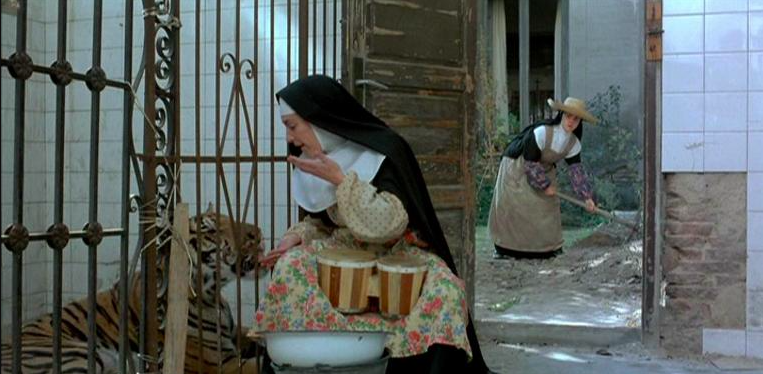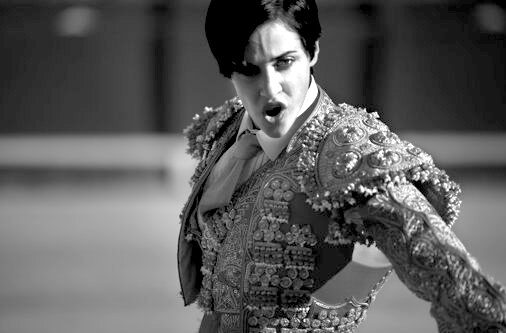The 80s marked an era of rupture with the forty years of fascism and the nostalgic embracement of Church-State imperial politics, and a subversion of the highly documented National that underscored the slow release of democracy–a state still not fully achieved in the Peninsula. This week we discussed the contribution of religious institutions, gender unalignment, governmentality, satire, and democracy to the representation of fascism and religiosity in Spanish cinema, as well as the roles these concepts play in a film critique of imperial politics and in the configuration of historical memory in the decade of the 1980s in Spain.

On Tuesday we dwelled in the explosive filmic representation of comic and tragic history as media cultivated by filmmaker Pedro Almodóvar, and we focused on his efforts to disseminate this rupture and subversion at a global level. On Thursday we explored Almodóvar’s loud filmic representation of the religious institution of conventual life in his 1983 satire Entre tinieblas / Dark Habits and how he weaves the convent with its polar opposite world of prostitution and drugs.
For this week’s reflection, choose two concepts (Post-Franco Spain, gender unalignment, documenting the National, satire, governmentality) and write about how you see them woven by Almodóvar in this film.
This blogpost does not have a deadline. Please, make sure you do not let posting accumulate for the day before the notebook and all blogposts are due on April 28.
NOTE: We had melodrama in our learning objectives listed in Canvas; this is a crucial term in the study of Post-Franco cinema. However, we focused on other terms, such as governmentality and gender unalignment, which are as important for the analysis of this decade of Post-Francoism and of this film. We’ll come back to melodrama in two weeks, when we discuss Julio Medem’s Lovers of the Arctic Circle.

In what we now might consider Post-Franco Spain, Almodóvar works in his films to comment on the time of dichotomy in Church and State, as the two begin to separate, but also still are deeply intertwined after centuries of connection. Dark Habits, perfectly explores this idea as we see the epitome of the Catholic church — a convent — being used as a tool against the State while still enjoying the benefits of being above the law.
The convent acts as a safehaven for prostitutes, murderesses, drug addicts, etc. which are all enemies of the state in the way and would be arrested if they were found out. In such, the convent is betraying the government that they are living under as they harbor these criminals. Here, a sense of governmentality plays into this concept, as they do not follow the notions of a sovereign state, but rather work independently from such. There seems to be very little concern with the law on behalf of the nuns as they engage with illegal activity constantly. This seems to be a privilege of the church’s previous close connections with the state. In a way the nuns are above suspicion of breaking the law, because historically they seem to be the model of the law. Almodóvar plays with this in an ironic way in crafting Dark Habits which makes it the genius movie that we see today.
Last week, our class looked at the stark (and rapid) contrast between films released during Franco’s rule vs Entre Tinieblas, which seemed like a call to escape the shackles that Franco had left behind on popular media in the country. This film quite clearly establishes how freed or liberated many groups of people felt after 40 years of oppression, as well as shows the effects of La Movida Madrileña in the new punk, artsy expressionist era (the 80s primarily).
The two terms that can most clearly be seen in this film, for me, are Post-Francoist Spain and gender unalignment; both represent the exit out of the period of transition when there was less widespread national uncertainty and the tendency to express people’s true selves in secret which is where the convent comes in as a ploy to cover up all of the ‘dark habits’ the nuns are trying to keep hidden still. Almodovar’s choice to infuse queerness into figures who are supposed to represent purity, tradition, and the patriarchy completely shatters the boundaries of what most commonly watched Spanish cinema looked like. Almodovar almost seems to use this post-Franco period as an opportunity to venture out into a new category of unfiltered and uncensored films. The fact that nuns are the ones committing all of these crimes, but lokey, is representative of the corruption that has likely always gone on within the Catholic church, and Almodovar is just exposing it using such clever and satirical humor.
Almodovar’s Dark Habits is among the most interesting and wild films we have seen in this course. Shocking and humorous, this film is full of jarring images such as a nun shooting heroin or feeding a caged pet tiger. This satire pokes fun and reveals nuances of the relationship between Church and State in 1980s Spain. As democracy matured in the country, the Church, once a site of purity and authority in Spain, becomes a refuge for sinners, including lesbians, drug users, prostitutes, and murderers. Almodovar uses satire to point to the changing role of the Church in this era of Spain, which in the film is now a refuge for those on the margins of society, and no longer an authority on who is accepted. The film also investigates post-Franco Spain, as the country evolves past his rule but his legacy remains. This can be seen in the Church-State relationship, and through the police who enter the convent, surveilling the nuns. The nuns also have clearly endured a painful past, turning to the convent and other vices to cope, signaling the lingering trauma of Franco’s rule. The absurdity and imagination of this film, however, point to a Spain with more room for the marginalized and a greater tolerance for queerness.
Dark Habits is filled with comedy and would likely never be allowed to be produced under Franco’s rule by the censorship committee. It involves use of hard drugs and lesbianism as well as the discussion of murder and risqué writings.
The satire in this film is easy to spot even from the title. “Dark Habits” is a pun on the color of the nun’s clothing as well as their habits being not so heavenly. One sister writes risqué novels in her spare time, another trips LSD, and a third lusts after a chaplain in the church. The Mother Superior does hard drugs with another sister, Yolanda, and is a lesbian. There are many moments to laugh in this film but they are all based on satire or the ridiculing of others and acts through irony and jokes. Throughout the film the idea of every nun having a vice that would not be accepted in a traditional convent plays of the idea of piety and who is truly pious. Not even the Mother Superior or the Marquise are spared as one blackmails and the other prioritizes money over the saving of the convent. Among the hardships that the convent endures, the women throw a birthday party which shows irony as they are celebrating while their organization is crumbling.
Another interesting topic of discussion is the gender unalignment as mentioned above. In a non-binary tradition gender and sexuality system, love is thought to only be allowed to occur heterosexually and there would also only be 2 genders. In our experience we know that none of this is true. Love can occur between any people regardless of gender or sex and gender is not limited to 2. We are educated and know that a non-binary heterosexual system is not accurate to the actual genders of people and that sexuality is a spectrum. This film plays on the traditional roles of Spain (especially in 1983) as the Mother Superior is a lesbian. She falls in love with Yolanda (unfortunately unrequited). This incorporation of homosexuality in the film surrounded by satire shows us the assumed gender unalignment of Mother Superior. She is not acting as a traditional women because she does not love men and is not interested in pursuing a relationship with a man. This representation in film so early in theaters is beneficial to the LGBTQIA+ community, but unfortunately it being drowned in satire means that this identity is being used as the “butt of a joke” so to speak. In gender unalignment is represented despite it being surrounded by satire.